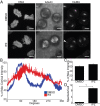RanGTP and CLASP1 cooperate to position the mitotic spindle
- PMID: 23783028
- PMCID: PMC3744954
- DOI: 10.1091/mbc.E13-03-0150
RanGTP and CLASP1 cooperate to position the mitotic spindle
Abstract
Accurate positioning of the mitotic spindle is critical to ensure proper distribution of chromosomes during cell division. The small GTPase Ran, which regulates a variety of processes throughout the cell cycle, including interphase nucleocytoplasmic transport and mitotic spindle assembly, was recently shown to also control spindle alignment. Ran is required for the correct cortical localization of LGN and nuclear-mitotic apparatus protein (NuMA), proteins that generate pulling forces on astral microtubules (MTs) through cytoplasmic dynein. Here we use importazole, a small-molecule inhibitor of RanGTP/importin-β function, to study the role of Ran in spindle positioning in human cells. We find that importazole treatment results in defects in astral MT dynamics, as well as in mislocalization of LGN and NuMA, leading to misoriented spindles. Of interest, importazole-induced spindle-centering defects can be rescued by nocodazole treatment, which depolymerizes astral MTs, or by overexpression of CLASP1, which does not restore proper LGN and NuMA localization but stabilizes astral MT interactions with the cortex. Together our data suggest a model for mitotic spindle positioning in which RanGTP and CLASP1 cooperate to align the spindle along the long axis of the dividing cell.
Figures






References
-
- Albertson DG. Formation of the first cleavage spindle in nematode embryos. Dev Biol. 1984;101:61–72. - PubMed
-
- Clarke PR, Zhang C. Spatial and temporal control of nuclear envelope assembly by Ran GTPase. Symp Soc Exp Biol. 2004;56:193–204. - PubMed
-
- Du Q, Macara IG. Mammalian Pins is a conformational switch that links NuMA to heterotrimeric G proteins. Cell. 2004;119:503–516. - PubMed
Publication types
MeSH terms
Substances
Grants and funding
LinkOut - more resources
Full Text Sources
Other Literature Sources
Molecular Biology Databases
Research Materials
Miscellaneous

